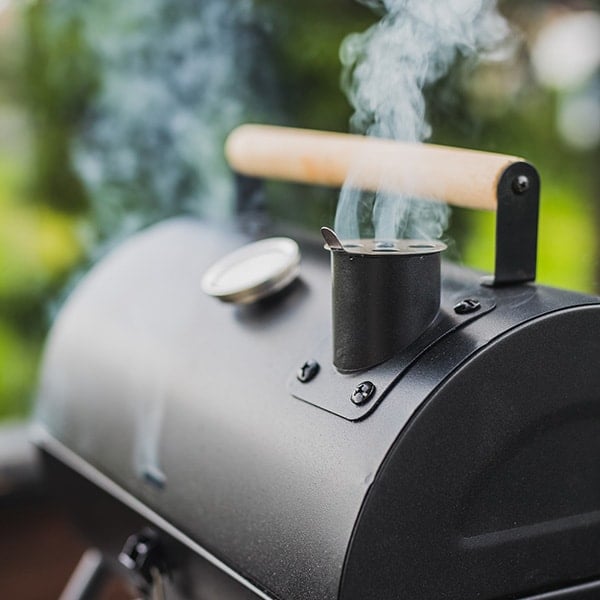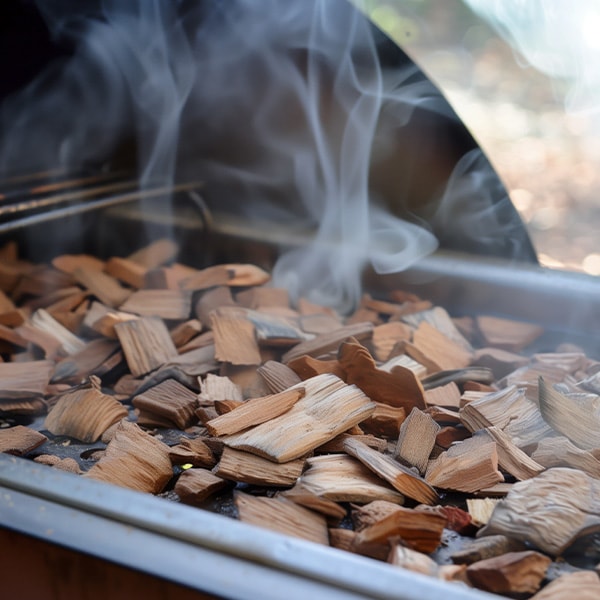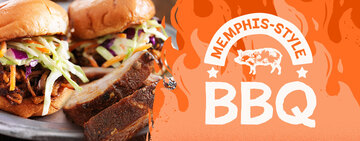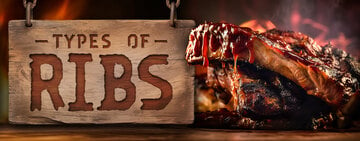
Nothing beats the savory flavor of melt-in-your-mouth BBQ. Achieving succulent smoked proteins takes time, patience, and practice. To help you get started, we created a guide to operating a commercial smoker, so you can add delicious smoked foods to your menu. While there are many commercial smokers you can choose from, for this article, we will use an offset smoker as our example since it is both the most traditional and popular meat smoking method. However, most of our tips and guidelines will cross-apply to other smoking units as well. Always refer to the instructions from your manufacturer.
Shop All Commercial Smokers
What Is a Meat Smoker?

A meat smoker is a cooking device that uses smoke and low temperatures to cook food in a controlled environment. This method of cooking involves burning wood chips or pellets to generate smoke, which circulates the food and infuses it with a distinct, smoky taste. In addition to adding flavor, smoking also helps preserve food by inhibiting the growth of bacteria and other harmful microorganisms. This makes smoked meats an ideal option for foodservice establishments looking to extend the shelf life of their products while offering customers a unique and delicious dining experience.
What Is an Offset Smoker?
Also known as horizontal smokers, offset smokers consist of a large main chamber where the meat is placed for smoking, and a separate firebox attached to the side. The firebox generates smoke and indirect heat, which is then drawn into the main chamber to cook the meat slowly and evenly. It's the timeless choice for creating American regional BBQ styles. They’re ideal for smoking large cuts of meat and can accommodate a significant amount of food at once.
How to Use an Offset Smoker
Offset smokers are a popular choice for smoking meat due to their ability to impart a rich, smoky flavor to a variety of cuts. By following these steps, you can create flavorful, tender smoked meats that are sure to impress your customers.
- Season Your Smoker - Before using your offset smoker for the first time, it's important to season it. This process involves coating the interior surfaces with a high smoke point oil and heating the smoker to create a protective layer that prevents rust and improves the flavor of your smoked meats.
- Prepare the Meat - Select your preferred cut of meat and season it with your choice of rubs or marinades. Allow the meat to come to room temperature before placing it in the smoker to ensure even cooking.
- Light the Fire - Start by building a fire in the firebox of the offset smoker using charcoal. Once the fire is established, allow the smoker to come up to the desired cooking temperature before adding the meat. For most meats, your smoker should be between 190 and 225 degrees Fahrenheit. The internal temperature of your meat will depend on the type and cut of meat you’re smoking.
- Control the Temperature - Maintaining a consistent temperature is crucial for smoking meat evenly and achieving the desired tenderness. Use the vents on the offset smoker to regulate airflow and control the temperature throughout the cooking process.
- Add Wood for Smoke - To infuse your meat with a rich, smoky flavor, add wood chips or chunks to the firebox of the offset smoker. Different types of wood can impart unique flavors, so experiment with options like hickory, apple, or mesquite for a personalized touch.
- Add Meat to Cooking Chamber - Once the smoker has reached the ideal temperature and is producing a steady stream of smoke, carefully place the prepared meat on the cooking grate inside the main chamber of the smoker.
- Monitor the Cooking Process - Throughout the smoking process, keep an eye on the temperature of the smoker and the internal temperature of the meat using a reliable thermometer. Adjust the airflow and add more wood as needed to maintain a consistent cooking environment.
How to Start a Fire in an Offset Smoker

Building and maintaining the fire in an offset smoker is one of the biggest challenges of smoking meat. You’ll need both charcoal and hardwood chunks to start and maintain your fire. The charcoal builds your base heat, and the hardwood chunks facilitate the delicious, smoky flavor. To maintain a proper temperature, invest in a reliable smoker thermometer. For an accurate temperature read, set the thermometer's probe at the grate level where you will be cooking your meat.
- Light Your Charcoal - Charcoal is the best way to start the fire in your offset smoker. You will add wood when your coals have enough heat. Use a chimney starter to light your coals.
- Add Coals - Once your charcoal coals are lit, add them to the firebox. Place them on the far side of the firebox so you won’t have to continue reaching over the fire.
- Add Wood - Start small with a couple of wood pieces and don’t sit them atop the coals yet. You want to give them a chance to warm up and dry out.
- Move Wood Over Coals - Once they’re dry, move the wood over the coals and wait for it to come to the desired temperature. While waiting, place another log into the firebox so it can warm up. Repeat this process every time you add a new log to the fire. The reason for heating the logs first is they catch fire faster. Plus, dried-out logs don’t produce white smoke, which is undesirable for the meat-smoking process.
- Adjust Chimney and Vents - With your smoker at the desired temperature, open the chimney cap 1/2 way and open the vents on the side of the firebox approximately 1/3 of the way.
- Recheck the Fire - If your log has turned into coals, it’s time to roll in the log that you heated and place another log in to heat up. This will be an ongoing process.
- Be Prepared to Readjust - Throughout your smoking process, you must check the temperature and adjust the vents to control the heat. You’ll want to make these adjustments gradually to control the temperature.
Tips for Maintaining an Offset Smoker’s Fire
While each offset smoker will require slightly different techniques, follow these guidelines for maintaining the fire in an offset smoker.
- Check the Fire - Check your fire pit every 45 minutes to an hour and add fresh wood.
- Check the Smoke - Without opening the fire pit door, check the temperature and the smoke released from the chimney every 15 to 20 minutes. This helps prevent any potential problems. If large volumes of white smoke are being released from the chimney, then check the firebox immediately.
- Managing Temperature Drops - If you’ve added a new log to offset a temperature drop, leave the firebox door cracked for a few minutes to reclaim your desired temperature.
- Rotate Meat - With all the careful fire management in the world, there can still be a 75-degree Fahrenheit difference in the cooking chamber from one end to the other. You must rotate the meat, so it cooks evenly.
- Use Two Digital Thermometers - Because there can be a 75-degree difference in the cooking chamber from one end to the other, place meat thermometers at both ends of the cooking chamber.
- Keep Lids Closed - While you will periodically need to open the lids of the firebox and smoking chamber, you want to keep these checks as minimal as possible. Rely on the thermometer readings and the quality of smoke released from the chimney for most of your checks.
Smoker Tips

To ensure optimal performance and delicious results when using a commercial smoker, consider the following tips:
- Season Your Smoker - Before using your offset smoker for the first time, it's essential to season it. This process helps to remove any manufacturing residues and coat the interior with a layer of oil to prevent rust and improve flavor.
- Maintain a Consistent Temperature - Consistency is key when using an offset smoker. Monitor the temperature regularly using a reliable thermometer and adjust the airflow and fuel as needed to maintain a steady cooking temperature.
- Use Quality Wood - The type of wood you use in your offset smoker can significantly impact the flavor of your meats. Choose high-quality hardwoods like oak, hickory, cherry, or apple for the best results.
- Preheat Your Smoker - Preheating your offset smoker before adding your meat is crucial for achieving even cooking and preventing flare-ups. Allow your smoker to reach the desired temperature before placing your meat inside.
- Minimize Fluctuations - Avoid constantly opening the smoker's lid during the cooking process, as this can cause fluctuations in temperature and extend the cooking time. Only open the lid when necessary to check on your meat or add more wood or charcoal.
- Use a Water Pan - Placing a water pan in your offset smoker can help regulate the temperature and maintain moisture levels inside the cooking chamber, resulting in juicier and more flavorful meats.
Offset Smoker Cleaning and Maintenance
Proper cleaning and maintenance of your offset smoker are essential to ensure its longevity and optimal performance. By following these simple steps, you can keep your offset smoker in top condition for years to come.
- Let Unit Cool - After each use, allow the offset smoker to cool down completely before cleaning.
- Remove Residue - Remove any leftover ashes, charcoal, or wood chips from the firebox and cooking chamber. Use a brush or scraper to clean the grates and interior surfaces.
- Wash Unit - Wash the grates and cooking chamber with warm, soapy water and a sponge to remove any grease, food residue, and carbon buildup. Rinse thoroughly and dry with a clean cloth.
- Clear Chimney - Check the chimney and vents for any obstructions or buildup. Use a chimney brush to clean out any debris and ensure proper airflow during cooking.
- Inspect for Damage - Check the seals and gaskets around the cooking chamber and firebox. Replace any damaged or worn-out seals to prevent heat loss and maintain consistent temperatures.
- Don’t Neglect the Exterior - Regularly clean the exterior of the offset smoker with a mild detergent and water to remove dirt, grease, and grime. Avoid using harsh chemicals or abrasive cleaners that can damage the finish.
- Re-Season the Smoker - To prevent rust and corrosion, season the offset smoker regularly. Apply a thin layer of cooking oil to the grates and interior surfaces after cleaning and before storage to create a protective barrier.
- Store Safely - Store your offset smoker in a dry, covered area to protect it from the elements and prevent rust. Use a high-quality cover to shield the smoker from dust, moisture, and UV rays when not in use.
- Schedule an Annual Inspection - Conduct a thorough inspection of your offset smoker at least once a year to check for any signs of wear, rust, or damage. Address any issues promptly to avoid costly repairs and ensure continued performance.
Types of Smokers

While offset smokers are the most traditional, meat smokers come in various designs, such as vertical, pellet, and electric. Each type of smoker offers different features and benefits, allowing chefs and foodservice operators to choose the one that best suits their needs. If you don’t have the space or capacity to operate an offset smoker, here are the other pieces of equipment you can use to create delicious smoked meat.
- Vertical Smokers - Also known as cabinet smokers or bullet smokers, vertical smokers are designed with a vertical orientation, with the heat source at the bottom and the cooking racks stacked on top of each other. They’re compact and space-efficient. You can smoke hot or cold in vertical units, allowing you to smoke a variety of meats, fish, and vegetables.
- Pellet Smokers - Pellet smokers use wood pellets as the fuel source, which are automatically fed into a firebox to generate smoke and heat. These smokers are easy to use and maintain, making them a popular choice for commercial kitchens looking for convenience and consistency. Pellet smokers offer precise temperature control and produce a clean, consistent smoke flavor.
- Electric Smokers - Powered by electricity and known for their ease of use, electric smokers are equipped with heating elements and temperature controls, allowing you to set the desired temperature and forget about it until the meat is perfectly smoked. They’re ideal for busy commercial kitchens that want a hassle-free smoking experience without the need for constant monitoring.
- Drum Smokers - Drum smokers, also known as barrel smokers, are simple yet effective smokers that consist of a large drum or barrel with a firebox at the bottom. These smokers are versatile and can be used for both smoking and grilling, making them a popular choice for commercial kitchens looking for multi-functional smokers.
Back to Top
Whether you’re opening a BBQ restaurant or looking to create a smoked fish dip for your appetizer lineup, knowing how to use a smoker opens a world of possibilities for your menu. Smoking proteins transform less expensive, tough cuts of meat into melt-in-your-mouth entrees, making this an economical cooking method. You can also experiment with smoking vegetables for plant-forward menu items or try smoking drink ingredients like simple syrup to create smokey cocktails.





